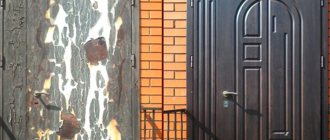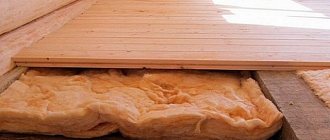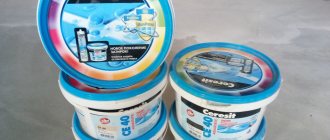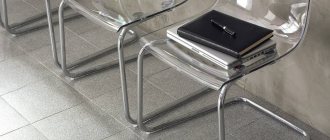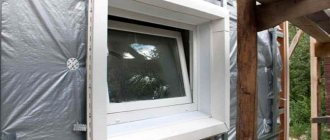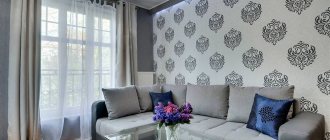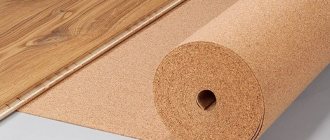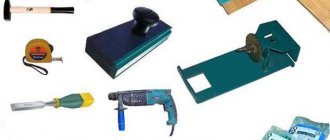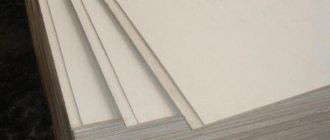Types of fiberboard by density
There are 4 types of slabs based on density, let’s take a closer look:
- Soft – low density up to 400 kg/cube, m, grades 1-3;
- Semi-solid - average density 400-800 kg/cube, m, NT grade;
- Solid – high 800-950 kg/cube, m, grade T;
- Super-hard – increased, over 950 kg/cube, m, grade ST.
The density of fiberboard is reflected in the areas of their application. Soft boards are used as soundproofing material. Semi-solid sheets are popular in the furniture industry. Solid versions are used for the production of walls located behind the furniture.
Super-hard models are used for flooring, wall decoration, building partitions between rooms, and making doors.
MDF or chipboard in the kitchen, which is better?
Kitchen furniture is exposed to temperature changes, high humidity, mechanical stress, household chemicals and other active reagents. The material must resist these negative influences and ensure a long service life.
The most in demand in the manufacture of facades for kitchen furniture are MDF and laminated chipboard. They have some similarities, but differ in composition, production technology, and performance characteristics. To determine which of these materials is best suited for the kitchen, you need to consider the features of each.
Types of fiberboard by type of cladding
- Fibreboard without treatment is called sheets with an untreated front plane.
- A covering with a decorative plane is called hardboard. Paint or finely dispersed wood pulp can serve as a decorative ball.
- Fiberboard with a combined, decorating plane, which includes tinted, finely dispersed wood mass.
- Laminated fibreboard. Such raw materials made from wood fiber fabric have moisture resistance and high strength, which is achieved through a mixture of synthetic resins used for its surface.
Types and classes
The main classification of fiberboard is by purpose and density. According to their intended purpose, fibreboards are of general and special types. Special - these are with some special properties. Three main groups can be distinguished:
- Moisture resistant (bituminized). When preparing the mixture, bitumen is added to it, which improves resistance to moisture.
- Difficult to burn. Fire retardants are added to the starting material, which reduce the flammability of the finished material.
Thin sheets bend well, thick sheets have high rigidity, so the material can be used for different purposes. - Finishing - with one side refined. The front side of the fiberboard can be painted, glued with a polymer film that imitates various materials: wood, stone, brick, tile, etc.
Finishing types of fiberboard - with one side treated - are also classified as special-purpose materials. There are a lot of subspecies and they can be called differently:
- Fibreboard with a lined or painted surface, smooth on the back (produced by dry pressing). In colloquial speech, such material is usually called “hardboard”. This is usually a medium density material.
- The same thing, but with a non-smooth back surface, is called “masonite” (wet pressing). Sheathing a dacha with fiberboard is a common solution
- If the front side of the material is glued with film - laminated - this material is called laminated fiberboard, sometimes the abbreviation LDVP is found.
General purpose fiberboard is also called construction fiberboard. This class can include materials of both dry (with two smooth surfaces) and wet production methods.
Price or quality?
Typically, the main criterion when choosing general-purpose fiberboard is low price. If you use it to cover the frame, a lot of material is required, so you want to save money. But you shouldn't chase cheapness.
The quality of fiberboard is determined by the absence of foreign inclusions or delamination
Cheaper fiberboard sheets are made with more formaldehyde. This substance in large quantities contributes to the development of cancer. To make your home safe, you should not use material with an emission class higher than E1 for interior cladding. Materials with class E1 are absolutely safe. They emit as much formaldehyde as natural wood.
Classification of fiberboard by grade
Depending on the quality of processing, fiberboard planes are divided into first and second grade products.
The marking is indicated in the form of Roman letters.
- First grade - there should be no protrusions on its surface. Most errors in the form of chips, paraffin stains and water are allowed only in small quantities. The change in shade, if any, should contain no more than 5% of the sheet surface.
- Second grade - only chips deeper than 5 mm and paraffin stains with a length of 10 cm2 per 1 m2 are not allowed. All other defects of the front plane are not regulated, but depend on the conscience of the manufacturer.
It should be noted that second-rate products are often purchased for use in those places where it is subsequently planned to be covered with finishing or other details.
Kitchen facades: MDF, chipboard, plastic or solid wood?
Your repost will change the Internet
